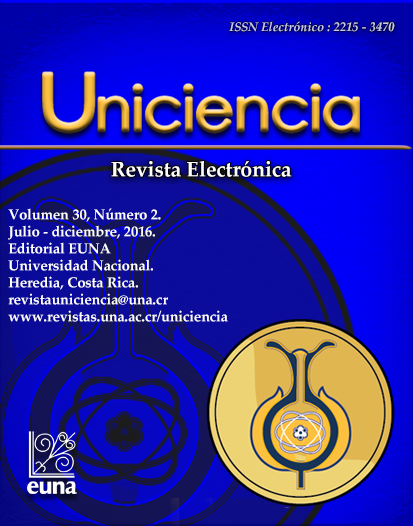Statistical Evaluation of the Levels of Mercury Detected in Billfish in Costa Rica, for 2003-2013
DOI:
https://doi.org/10.15359/ru.30-2.2Keywords:
Mercury, analysis, statistics, billffish, Costa Rica, LANASEVE.Abstract
The billfish, like marlin, fish sailing and swordfish are pelagic predators, top in the food chain; large specimens contain significant levels of methyl mercury (MeHg+) in their tissues. In the current work, all mercury analysis records in billfish were reviewed, classified, tabulated, and statistically analyzed, for the period 2003-2013 by Laboratorio Nacional de Servicios Veterinarios or LANASEVE (National Laboratory of Veterinary Services). The mercury levels had a Poisson type distribution behavior; the majority of the analysis were associated with samples fluctuating in the range of fish 0.2 mg Hg/kg to 0.4 mg Hg/kg. Compared to swordfish, there was a greater dispersion in marlin mercury levels. Average mercury concentration in marlin was 0,583 mg Hg / kg, while in swordfish it was 0,533 mg Hg / kg. The Valores de Ingesta Semanal Tolerable Recomendada o ISTR (Tolerable Weekly Intake Values Recommended) for marlin consumption were 165 g/week for pregnant women and 96 g/week for children, meanwhile for swordfish were 180 g/week and 105 g/week, respectively. Slightly higher mercury levels in marlin suggest a lower weekly consumption compared to swordfish.
References
Agencia Catalana de Seguridad Alimentaria. Metilmercurio. (2011). ACSA Brief Salud y Seguridad Alimentaria, Departament de Salut 2011. Recuperado de http://www.gencat.cat/salut/acsa/html/es/.../acsabrief08-2011metilmercurio.pdf
Asamblea Legislativa de la República de Costa Rica. (2005). Ley 8436. Ley de Pesca y Acuicultura. Publicado en La Gaceta, número 78, del 25 de abril del 2005.
Bloom, N. S. (1992). On the methylmercury content of fish tissue. Canadian Journal of Fisheries and Aquatic Sciences. 49, 92113.
Comisión de las Comunidades Europeas. (2007). Reglamento (CE) No 333/2007 de la Comisión de 28 de marzo de 2007 por el que se establecen los métodos de inorgánico, 3-MCPD y benzo(a)pireno en los productos alimenticios. Diario Oficial de la Unión Europea 2007, 88/29-88/38. Recuperado de http://www.boe.es/doue/2007/088/L00029-00038.pdf.
Departamento de Pesca de la FAO. (1994). Examen de la situación mundial de las especies altamente migratorias y las poblaciones transzonales. FAO Documento Técnico de Pesca. No. 337. Roma, FAO. 75p. ISBN 92-5-303523-4. Recuperado de: http:/ http://www.fao.org/docrep/003/t3740s/t3740s00.htm
EFSA. (2012). Scientific Opinion on the risk for the public health related to the presence of mercury and methyl mercury in food. EFSA Journal, 10(12), 2985.
ELIKA. (2005). Mercurio en pescado. Araba, España: Fundacion Vasca para la Seguridad Agroalimentaria.
Farré. R., Cameán. A. M., Vidal, M. C., Santacruz, A. L., Teruel, V. J. y Canales, E. T. (2010). Informe del Comité Científico de la Agencia Española de Seguridad Alimentaria y Nutrición (AESAN) en relación a los niveles de mercurio establecidos para los productos de la pesca. Revista del Comité Científico, 12, 29-36. Recuperado de http://aesan.msssi.gob.es/AESAN/docs/docs/evaluacion_riesgos/comite_cientifico/MERCURIO_P.PESCA.pdf
FDA. (2014). Mercury Levels in Commercial Fish and Shellfish (1990-2010). Silver Spring, U.S.A.: U.S. Food and Drug Administration. Recuperado de: http://www.fda.gov/food/foodborneillnesscontaminants/metals/ucm115644.htm
House of Representatives. (2012). Billfish Conservation Act of 2012. Recuperado de www.congress.gov/112/crpt/hrpt656/CRPT-112hrpt656.pdf
INCOPESCA (2008). Comunicación de acuerdo 476-2008. Recuperado de http://www.fecop.org/wp-content/.../ACUERDO-476-2008-PEZ-VELA-1.pdf
Joint FAO/WHO Expert Committee on Food Additives. (2003). Contaminants: Methylmercury. En WHO Technical Report Series, 922 (Ed.). Evaluation of Certain Food Additives and Contaminants: Sixty-first report of the Joint FAO/WHO Expert Committee on Food Additives 2003; 132-141. Rome, Italy. Recuperado de http://whqlibdoc.who.int/trs/WHO_TRS_922.pdf
LANASEVE. (2012). Formulario SEG-PE-001-RE-002 Recepción de muestras para alimentos (xls). Recuperado de: http://www.senasa.go.cr/senasa/sitio/index.php/archivos/view/1098.
Mar Viva, INCOPESCA, MEIC. (2012). Guía de identificación de filetes de pescado y mariscos. Recuperado de http://marviva.net/images/Consumo_Responsable/guia_de_identificacion_de_filetes_de_pescado_y_mariscos.pdf
SENASA. (2012). Toma y manejo de muestras oficiales en productos pesqueros. Dirección de Inocuidad de Productos de Origen Animal. Recuperado de: http://www.senasa.go.cr/senasa/sitio/files/120912023910.pdf
The Billfish Foundation. (2015). What are billfish? Recuperado de http://www.billfish.org/education/what-are-billfish/
Downloads
Published
How to Cite
Issue
Section
License
Authors who publish with this journal agree to the following terms:
1. Authors guarantee the journal the right to be the first publication of the work as licensed under a Creative Commons Attribution License that allows others to share the work with an acknowledgment of the work's authorship and initial publication in this journal.
2. Authors can set separate additional agreements for non-exclusive distribution of the version of the work published in the journal (eg, place it in an institutional repository or publish it in a book), with an acknowledgment of its initial publication in this journal.
3. The authors have declared to hold all permissions to use the resources they provided in the paper (images, tables, among others) and assume full responsibility for damages to third parties.
4. The opinions expressed in the paper are the exclusive responsibility of the authors and do not necessarily represent the opinion of the editors or the Universidad Nacional.
Uniciencia Journal and all its productions are under Creative Commons Atribución-NoComercial-SinDerivadas 4.0 Unported.
There is neither fee for access nor Article Processing Charge (APC)





